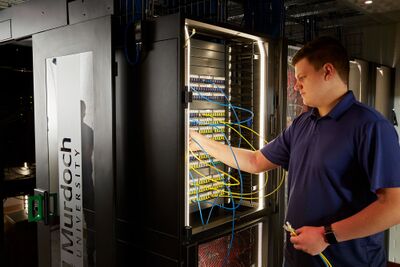Difference between revisions of "Main Page"
Jump to navigation
Jump to search
| Line 16: | Line 16: | ||
*[[Cyber Security Penetration Testing Activity]] | *[[Cyber Security Penetration Testing Activity]] | ||
*[[EternalBlue Windows 7]] | *[[EternalBlue Windows 7]] | ||
| − | |||
<!-- | <!-- | ||
*[[Mobile Applications Development]] | *[[Mobile Applications Development]] | ||
Latest revision as of 04:51, 20 July 2023
This is the public-facing main page of the Murdoch University Cyber Security & Networking Wiki. Here you can find information about The Lab Environment and our Teaching Philosophy. We teach applied Cyber Security & Networking content. Here we have made the provided the activities that we deliver to the community as well as some lab content from a number of units in this area.
The Wiki environment that you see here is also the method that we use to write teaching materials and the majority of the users of this site are students studying our units.
Contents
Outreach Content
- The Lab Environment and our Teaching Philosophy
- Examining Memory Dumps with Volatility
- Internet of Things Outreach
- IoT
- Crack the Code
- Cyber Security Penetration Testing Activity
- EternalBlue Windows 7
Server Environments and Architectures
- Obtaining a Linux Environment
- Ubuntu Desktop Familiarisation
- Linux Services
- Total Cost of Ownership (TCO)
- Linux Permissions
- Amazon EC2 Web Services
- DNS
- DNS via Route53
- Obtaining a Digital Certificate from Lets Encrypt
- Scripting Linux Server Functions
- Windows Server in EC2 Intro
- Windows Server Virtualisation
- Windows Server Scripting
Advanced Wireless
- Broadband options
- Your own mobile Linux box
- SSH Keys et al
- Broadband CPE Scenarios with Mikrotik and DD-WRT
- RTS/CTS and Network Analysis using Wireshark
- Performance Tuning
- Roaming
- Viewing the physical layer using WiSpy
- SSID Hiding and MAC Filtering
- WEP Cracking
- WPA Cracking
- Wireless Bridging
- Virtual Interfaces
- Enterprise Authentication using FreeRADIUS
- Network Analysis Lab
- Network Forensics with Wireshark
- Forensic Examination of Packet Captures
- GPON PPPoE
- Wireguard VPN
- Open VPN
- Splunk
- Alpha USB in monitor mode
- CGNATs and IPv6 over Mobile Broadband
2020
- Obtaining_a_Linux_Environment && Iriun && Writing && Presenting - Week 1
- Linux Essentials & VM Networks - Week 2
- Searching Filesystems && Linux_Permissions && IoT Coding basics - Week 3
- Network Forensics with Wireshark && Forensic Examination of Packet Captures - Week 4
- Week 5 - No lab work
- Splunk - Week 6
- Tunneling Services - Week 7
- Wireguard VPN - Week 8
- Open VPN - Week 9
- Writing && Presenting - week 11
Internet of Things
Short Courses
Unit
- Unit Introduction && Iriun && Writing && Presenting - Week 1 ->
- Obtaining_a_Linux_Environment - Week 2
- Contactless Doorbell with If This Then That && Amazon Alexa & IoT && Switching power with IFTTT - Week 3
- Linux Essentials & VM Networks - Week 4
- IoT Coding basics - Week 5
- Install Raspberry Pi OS and basic networking OLD: Install Raspbian on the Pi and basic networking OR Install Raspbian get connected and basic networking - Week 6
- Raspberry Pi and Basic Electronics - Week 7 ->
- Students Pitch an idea - Week 8 - > Students do 6 minute pitch presentation in class
- Raspberry Pi and Sensors - Week 9
- BluetoothLE on a Raspberry Pi - Week 10
- Running the Raspberry Pi as a Bluetooth Peripheral - Week 11
- Project work/assistance - Week 12
- Final Presentations - Week 13
EVE - Network Emulator
- Configuring IP addresses with EVE virtualPC
- Spanning Tree Default Behaviour
- Spanning Tree Manipulating the root bridge
- Multiple Spanning Tree
- EVE OSPF Routing
- OSPF Multi-area and Route Summarisation
- EVE_Basic_ACLs
- EVE_ACL_Challenge
- EVE_NAT
Multi purpose
- Writing a Research Essay
- Writing
- Presenting
- Searching Filesystems
- SSH Keys et al
- Obtaining a Linux Environment
- Your own mobile Linux box
- Connecting to the Murdoch VPN
- Linux MOTD
- Iriun
- RFID with the Proxmark3
- Hardware Hacking
- Yocto Light

